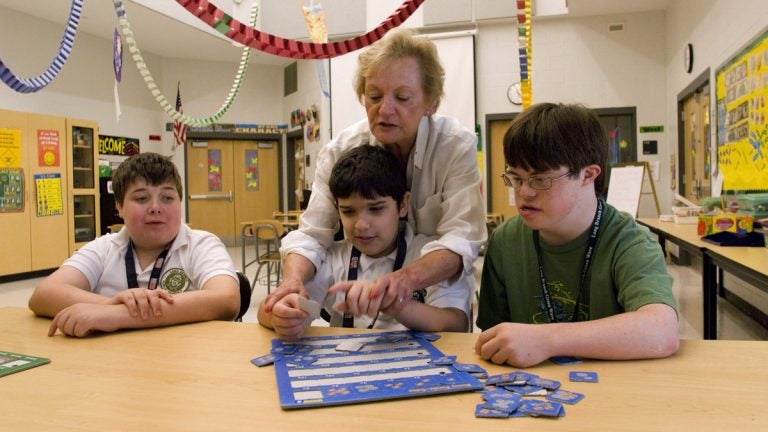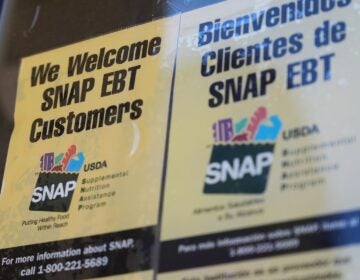N.J. should end its segregation of special needs students

Special education teacher Karen Hansen works with students at the Long Branch Middle School in Long Branch, N.J., Friday, June 1, 2007. (AP File Photo/Colin Archer)
Last month a federal court ruled that New Jersey’s public school system unlawfully segregates children with disabilities in isolated schools and classrooms. This is old news.
Federal law (I.D.E.A.) mandates that children with disabilities have access to a “free public education” in “the least restrictive environment.” Mountains of case law, not to mention federal and state regulations, require local districts to work hard to integrate special needs kids into regular classrooms instead of self-contained classrooms, where children are segregated from typical peers, and out-of-district placements in private and public special education schools.
However, according to court documents, N.J. continues to disproportionately keep our special needs students out of the regular classroom, a habit so ingrained into our educational psyche that the only hope for a cure is an intervention.
According to the Settlement Agreement in “Disability Rights N.J. v. N.J. Department of Education,” N.J. must now implement a new monitoring system for our worst offenders, 75 school districts with the highest rates of segregation.
There are two parts to our lack of compliance. First, New Jersey classifies an unusually high number of students as disabled, which is the legal precursor to access to services like speech, occupational, physical, and behavioral therapies.
According to 2012 U.S. Department of Education data, N.J. is 5th highest in the nation with 17 percent of its students labelled disabled. The national average is about 13 percent. And here’s the second part to our habit: New Jersey is number one in the nation when it comes to isolating our special needs students in self-contained classrooms for much of the day and in public and private special education schools.
Last month’s court ruling shed light on just how bad it is: “while N.J. accounts for only about 3.8 percent of children in the U.S. receiving special education services, 9.0 percent of all segregated placements nationally are for such children in New Jersey.
“ For minority students in N.J. segregation of special needs students is the highest. From the ruling: “While comprising 17.7 percent of the total public school enrollment in 2004, African-American children accounted for 22 percent of the students classified for special education services, and 32.8 percent of the students in segregated placements.
“ There are a number of reasons why New Jersey has such a terrible record of removing special needs kids from the regular classroom. We have too many school districts for the state’s size. With some 600 districts, it’s difficult for many of the smaller ones to effectively staff special programs. What we’re left with is a thriving industry of private special education schools.
Other factors that push N.J. to separate special needs students from regular classrooms include; a litigious culture; and a school funding formula that awards extra money for children who have educational expenses.
Let’s look how this plays out in several districts, including a few of the 75 districts cited in the Settlement Agreement for unduly segregating students with disabilities.
Middle Township (Cape May County) is listed in the Consent Agreement as “non-compliant.” According to DOE data, 23 percent of its students are eligible for special education services. Ten percent of those students are bussed away to private or public placements, away from typical peers, and almost half of the rest are segregated in self-contained classrooms for most of the day.
Trenton Public Schools (Mercer County) is a little better: only 19 percent of its (almost entirely black and Hispanic) student population is eligible for special education services. But an astounding 18 percent of that group is bussed away from typical peers. Nearby Robbinsville Public Schools (mostly white and Asian) sends only 6 percent of its classified students to out-of-district placements.
Lakewood Township (Ocean County) is cited several times in the Consent Agreement and the district’s budget tells the story. Lakewood’s annual operating budget is about $107 million. Almost 20 million of that total, or 20 percent, goes to pay tuition at private special education schools.
Of course, this about children, not money. While some students with disabilities are best served in restrictive settings, the Court painstakingly describes cases of children who are hurt by our bad habits. One little girl, identified as “TG,” was diagnosed with a reading disability in second grade. Her parents advocated for specialized reading instruction while the district offered only placement in a self-contained classroom. For two years TG was segregated from her peers, doing the same assignments but without reading programs that addressed her disability. After two years her parents got a lawyer and TG got integrated instruction with appropriate support. And this ruling got it right: it’s time for an intervention in New Jersey.
___________________________________________
Laura Waters is president of the Lawrence Township School Board in Mercer County. She also writes about New Jersey’s public education on her blog NJ Left Behind. Follow her on Twitter @NJLeftbehind.
WHYY is your source for fact-based, in-depth journalism and information. As a nonprofit organization, we rely on financial support from readers like you. Please give today.





